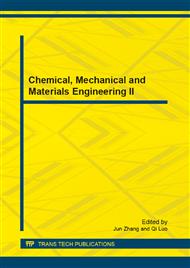[1]
Y.X. Wu and M.Z. Lu: Chin. J. Nat. Med. Vol. 4 (2002), p.227.
Google Scholar
[2]
T.M. Xu, X.Y. Sun and J.N. Ye: Chin. J. Environ. Sci. Vol. 4 (1983), p.38.
Google Scholar
[3]
E.L. Machado, M.B. Rosa, E.M.M. Flores, J.N.G. Paniz and A.F. Martins: Anal. Chim. Acta Vol. 380 (1999), p.93.
Google Scholar
[4]
A.M. Jimenez, M.J. Navas and G.Galan: Appl. Spect. Rev. Vol. 32 (1997), p.141.
Google Scholar
[5]
C. Eipel, P. Jeroschewski and I. Steinke: Anal. Chim. Acta Vol. 491 (2003), p.145.
Google Scholar
[6]
T. Takayanagi and P.K. Dasgupta: Talanta Vol. 66 (2005), p.823.
Google Scholar
[7]
I. Cesarino, F.C. Moraes, S.A.S. Machado and J.P. Filho: Electroanal. Vol. 23 (2011), p.1512.
Google Scholar
[8]
R. Knake and P.C. Hauser: Anal. Chim. Acta Vol. 459 (2002), p.199.
Google Scholar
[9]
G.Q. Gong, Q.Z. Zhu and H.G. Wang: Anal. Chim. Acta Vol. 298 (1994), p.135.
Google Scholar
[10]
E.P. Felix, J.P. Filho, G. Garcia and A.A. Cardoso: Microchem J. Vol. 99 (2011), p.530.
Google Scholar
[11]
H. Erxleben, J. Simon, L.N. Moskvin, L.O. Vladimirovna and T.G. Nikitina: Fres. J. Anal. Chem. Vol. 366 (2000), p.332.
Google Scholar
[12]
S. Ohira, P.K. Dasgupta and K.A. Schug: Anal. Chem. Vol. 81 (2009), p.4183.
Google Scholar
[13]
F. Berger, B. Ghaddab, J.B. Sanchez and C. Mavon: J. Phy. Conf. Ser. (2011), p.307.
Google Scholar
[14]
B. Ghaddab and J.B. Sanchez: Sens. Actuators B Vol. 170 (2012), p.67.
Google Scholar
[15]
A.H. Liang, Z.L. Jiang and B.M. Zhang: Anal. Chim. Acta Vol. 530 (2005), p.131.
Google Scholar
[16]
Z.L. Jiang, S.M. Zhou, A.H. Liang, C.Y. Kang and X.C. He: Environ. Sci. Technol. Vol. 40 (2006), p.4286.
Google Scholar
[17]
Z.L. Jiang, K. Li, H.X. Ouyang, A.H. Liang and H.S. Jiang. J. Fluoresc. Vol. 21 (2011), p.2015.
Google Scholar
[18]
Z.L. Jiang, B.M. Zhang and A.H. Liang: Talanta Vol. 66 (2005), p.783.
Google Scholar
[19]
Y.H. Luo, K. Li, G.Q. Wen, Q.Y. Liu, A.H. Liang and Z.L. Jiang: Plasmonics Vol. 7 (2012), p.461.
Google Scholar
[20]
Z. L. Jiang: Talanta Vol. 38 (1991), p.621.
Google Scholar


